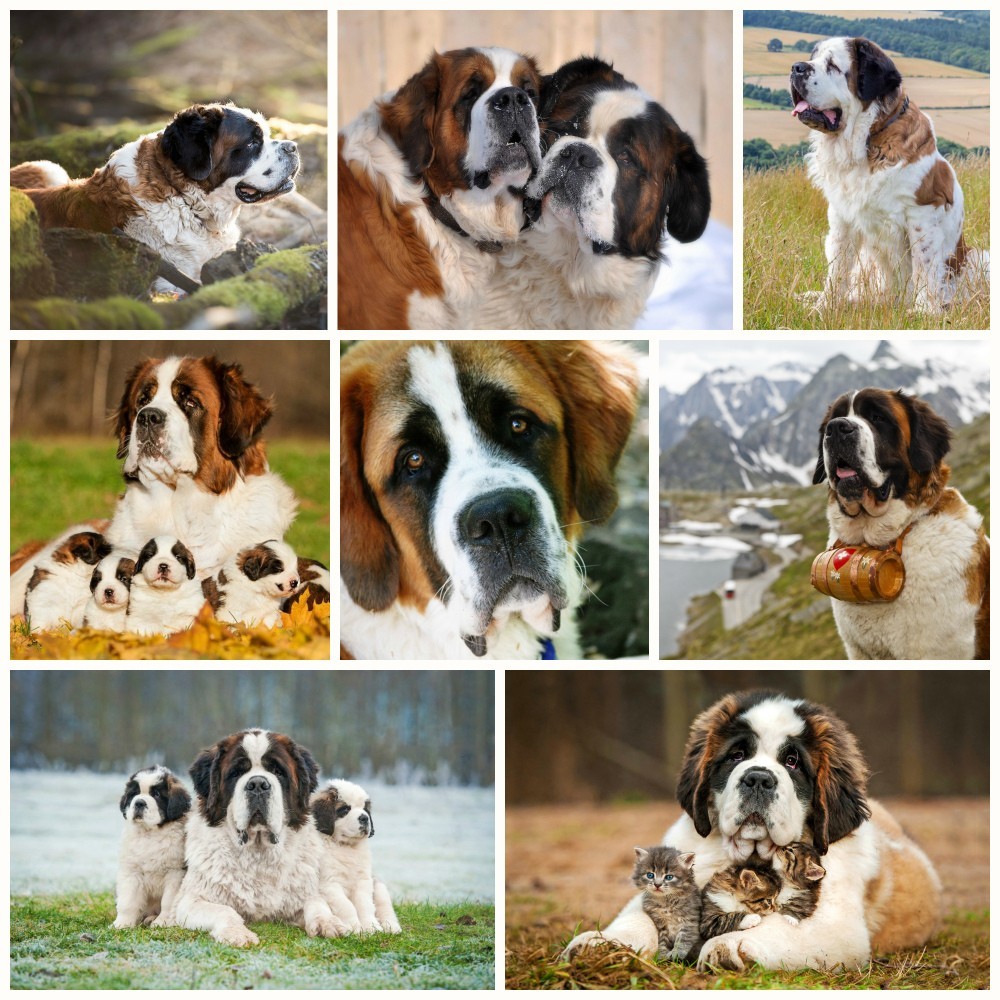St. Bernard is a giant dog with a kind heart, boundless love for the family, a willingness to stand on protection of his master and somewhat stubborn.

Brief description of the St. Bernard breed
St. Bernard is famous for his image with a keg of rum around his neck. In fact, these dogs have never brought alcoholic beverages to their owner. Such a picture - the result of a flight of fancy by the famous artist Edwin Landseer, who depicted a St. Bernard in this role during a visit to Switzerland in 1819. The public reacted positively to this picture, so the barrel of rum is still a symbol of this amazing breed.
The monks of the St. Bernard's shelter bred these dogs and used them during the search and rescue of lost tourists. It was from St. Bernard that the name of the breed came (literally, the name of the breed from English is translated as "Saint Bernard").
Today, this dog is, first of all, an excellent companion and friend with a fairly patient character. St. Bernard has many advantages, which led to the popularity of dogs of this breed. That is why it is worth knowing certain nuances regarding the health and upbringing of a pet.
If you want to be the owner of an excellent companion dog that can stand up for you at the right time, be prepared for the painstaking work of training and raising a pet.
St. Bernard belongs to the mastiff family, as evidenced by his large head, great growth and considerable strength. The dog is quite affectionate, but people are often scared large animal size, though such fear occurs mainly among intruders and uninvited guests.
The dog is moderately active, so the St. Bernard is suitable for people living in houses with a small yard. An unpleasant moment is abundant salivation and special sensitivity to temperature changes. Therefore, the pet should live in the house, and he needs to be given enough attention.
The little puppy is very cute and evokes love and charm from those around him. When purchasing a puppy of this breed, it should be understood that he will grow up and his weight will be from 50 to 70 kilograms. The most frustrating and heartbreaking fact for St. Bernard owners is their short lifespan, which ranges from 7 to 10 years.
Despite their impressive size, the St. Bernard's needs for food and exercise are very modest. He eats no more than other breeds of dogs, and as far as active exercise is concerned, a couple of short daily walks will be enough for the dog.
Like other dogs, puppies of this breed can cause damage to property. Most often, dogs can tear socks, towels, in general, various small things and decor or interior items. Particular attention should be paid to the fact that puppies can swallow the items mentioned. Be very careful that there are no reasons for contacting a veterinary clinic.
The St. Bernard is prone to heatstroke. Never leave your dog in the heat for long periods of time. The yard where the dog is located should be securely fenced, but when the whole family is at home, the pet should be with her!
St. Bernard has truly become a "saint" for many, especially the thousands of people he saved in the Swiss Alps.
https://moyhoroshiy.ru/porody-i-otzyvy/221100
Basic information about the St. Bernard breed
| Breed name: | st bernard |
| Country of origin: | Switzerland, Italy |
| The time of the birth of the breed: | mid 17th century |
| Type of: | Molossians |
| The weight: | 50 – 70 kg |
| Height (height at the withers): | 65 - 90 cm |
| Life Expectancy: | 7 - 10 years old |
|
ICF classification:
|
Group 2, Section 2, Number 55 |
| Puppies price: | 210 – 850 $ |
| Most popular nicknames: | list of nicknames for St. Bernard |
Evaluation of the characteristics of the St. Bernard breed
| Adaptability
(a definition meaning how easily a dog can adapt to changes in life) |
🐶🐶🐶🐶 |
| Shedding level
(Level and frequency of hair loss in the animal) |
🐶🐶🐶 |
| Tenderness level
(The level and amount of tenderness and affection that the dog gives in return for attention to itself) |
🐶🐶🐶🐶🐶 |
| Exercise needs
(Dog's daytime activity level) |
🐶🐶 |
| Social need
(The required number of contacts of the dog with other animals, as well as people) |
🐶🐶🐶🐶 |
| Apartment content
(A factor that determines the level of noise and other inconveniences that a dog can deliver to owners in relation to the size of the apartment to the size of the dog) |
🐶🐶🐶 |
| Grooming
(The number of bathing, brushing, and the number of professional grooming sessions required for the dog) |
🐶🐶🐶🐶 |
| Friendliness in an unfamiliar environment
(Features of the behavior of a dog in a society with strangers or in an unfamiliar environment) |
🐶🐶🐶 |
| Tendency to bark
(Tendency to bark and its frequency and volume) |
🐶🐶🐶 |
| Health issues
(Potential health status of the dog) |
🐶🐶🐶🐶🐶 |
| Territoriality
(The dog's tendency to protect his home, yard, or even his owner's car) |
🐶🐶🐶🐶🐶 |
| Friendliness to cats
(The tendency towards tolerance for cats and decreased manifestation of hunting instincts) |
🐶🐶🐶🐶🐶 |
| Intelligence
(The ability of the dog to think and solve emerging difficulties (not to be confused with learning!) |
🐶🐶🐶 |
| Education and training
(The level of difficulty in training the dog to perform certain actions) |
🐶🐶🐶 |
| Friendliness to children
(A factor that determines how friendly a dog is to children, whether he likes to play with them and tolerate some childish pranks) |
🐶🐶🐶🐶🐶 |
| Game activity
(The concept is determined by its very name, and, as a rule, is found in almost all dogs) |
🐶🐶 |
| Observation
(The ability of a dog to detect the presence of a stranger on its territory) |
🐶🐶🐶🐶🐶 |
| Friendliness to other dogs
(The tendency of the dog to find common language with his other relatives) |
🐶🐶🐶🐶🐶 |
Photo of St. Bernard:

History of the origin of St. Bernard
St. Bernards - these are the descendants of the Molossian dogs, from which mastiffs and other large breeds. Often these dogs were found on Swiss farms, where they helped with the housework: they dragged carts, guarded livestock and property, and warned of danger.
It is believed that the monks of the St. Bernard shelter in 1670 gave several dogs to local farmers who lived at the foot of the Alps, from there the spread of the breed began. When the monks realized that dogs had a keen sense of smell, St. Bernards began to be actively bred and used while searching for those lost in the mountains.
Due to the fact that the monks experienced certain problems with food, initially the St. Bernard was much smaller. But in 1830, the monks decided to increase the size of the dog and develop a breed with a thicker coat. The crossing of the St. Bernard with the Newfoundland began. As a result, a larger dog was bred, but the long hair obtained as a result of selection was a real disaster. The wool rolled up and froze in the snow, making it impossible to find people on the snowy slopes of the Alps.
The name "St. Bernard" originated around 1880. Until this period, dogs were called differently: "sacred dog", "alpine mastiff" and many others.
The first St. Bernard club was organized in America in 1887. The popularity of the breed is constantly growing. Already in 1960-1970, the St. Bernard became one of the most popular breeds in the United States, by 1971 the breed was ranked 4th among registered breeds. Today, the breed occupies an honorable 45th place.
The character of St. Bernard
The Saint Bernard is probably the most famous dog that helps rescue people. In the Swiss Alps, the St. Bernards were given the responsibility of rescuing thousands of people caught in an avalanche. These dogs do an excellent job with the difficult task of finding people under a dense snow cover. When a St. Bernard finds a person, he warms him with his warmth until rescuers arrive.
Today, these affectionate giant dogs make excellent companions. Puppies of this breed are somewhat clumsy and cause real cheerful chaos in the house. As puppies get older, they become more obedient. They are not averse to taking a nap in the sun, but they will not refuse frisky games in the yard with children.
St. Bernards love snowy weather, they will be happy to run in the snow or ride kids on a sled. Those people who adore active dogs will make the right choice if they get a dog of this breed.
Maintenance and care
The St. Bernard needs to be brushed at least three times a week. This must be done with a special brush. Twice a year, during the period of active molting, this procedure should be carried out even more often. Otherwise, the wool will quickly spread throughout the house.
Dogs of this breed do not need frequent bathing. It is better to do this as needed, and not in the bathroom, but in the shower, of course, if possible. Many owners practice bathing dogs of this breed in open water in nature. This procedure will please not only you, but, of course, your pet.
Representatives of this breed have a lot of tears. Because of this, peculiar dark spots form near the eyes. Therefore, it is necessary to wipe the eyes daily with a napkin and a special solution prescribed by the veterinarian. Otherwise, dark spots will appear under the pet's eyes.
Check your dog's ears regularly for inflammation, irritation, and dirt. Clean the ears with a special solution. In this case, the use of cotton swabs should be avoided.
Weekly brushing is sufficient to prevent tartar buildup and keep gums healthy. Also, this procedure will prevent the appearance of a characteristic bad breath. The nails are also trimmed every month.
Training and education of St. Bernard
Training St. Bernards is not easy, especially for beginner dog breeders. They have a wayward and stubborn character, so they do not always listen to the opinion of their master.
The behavior of these large dogs is akin to that of teenagers. They seem to be checking what they can get away with and what they will be punished for, so they often violate the rules of behavior that are somehow imposed on them.
It is important to start training St. Bernards at an early age, otherwise it will be much more difficult to do later. In the learning process, you must be firm and persistent, but in no case should you use rudeness and aggression.
Dogs of this breed respond well to various treats that can be successfully used in the training process. The entire learning process can take a long time, so patience is essential.
Health and disease
Some interesting facts
- The size of the St. Bernards is simply huge. Despite the fact that they are quite calm, they are still not quite suitable for keeping in an apartment due to their large size.
- As a rule, St. Bernards do not bark without a reason.
- The average life expectancy of a St. Bernard is 7-10 years.
- If you consider yourself a very clean person, then the St. Bernard will not suit you. These dogs prone to salivation, abundant molting, so it will not be easy to maintain cleanliness.
- The maturation process of St. Bernards is long. So they stay for a long time puppiesdespite the large size.
- This breed was bred to work in the Alps, that is, in a cold climate. St. Bernards do not tolerate heat well.
Nurseries and breeders
We borrowed material from the wonderful site of our partners DOGCATFAN.COM about cats and dogs, the author dogcatfan
